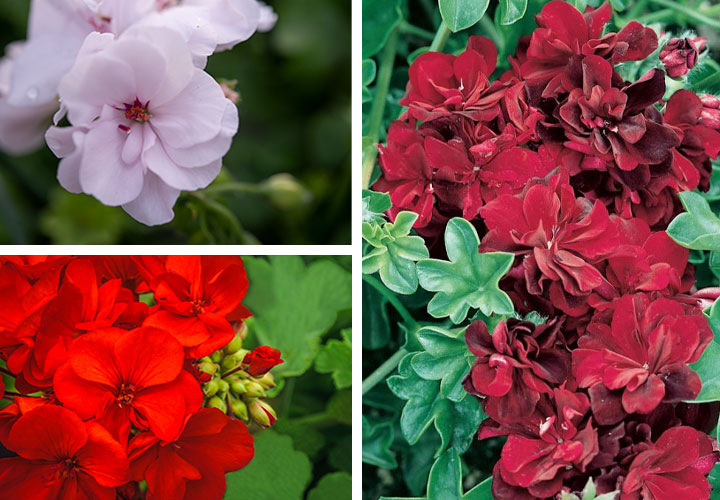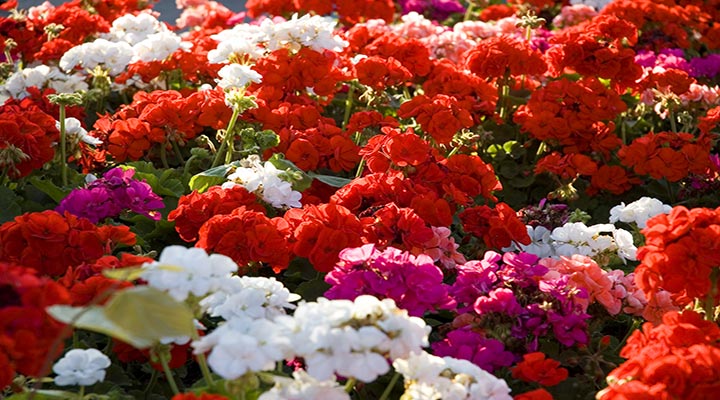Geraniums
All geraniums relish sunshine and warmth, and when I say geranium I actually mean pelargonium. The common garden geraniums – described as zonal geranium, ivy-leafed geranium, scented-leaf geranium and pelargonium – are in the genus Pelargonium. The reason the botanic distinction is important is that there is another group of perennial geraniums, generally referred to as species geraniums, in the genus Geranium. These perennials have a more delicate constitution than their robust Pelargonium cousins and do best in a cool climate or with special care in warm gardens.
Mediterranean vibe
The common garden geraniums are robust, heat-loving plants with heads of vibrantly coloured flowers and strongly scented (or to some people’s noses ‘stinky’) leaves. They grow easily from cuttings, thrive in pots or hanging baskets, and add a laid-back, Mediterranean or seaside holiday feel to gardens. These virtues make geraniums great plants for beginner gardeners or anyone gardening on a budget. They are also the plant of choice to dress up a sunny courtyard or balcony.
The classic geranium has bright red flowers with round green leaves often marked with a darker reddish purple pattern. This is the zonal geranium (Pelargonium x hortorum). As well as red, flowers are also pink, white and apricot and held above the leaves. Those with very double flowers are known as rosebud types as the flowers resemble tiny rose buds. Some zonals also have golden-toned or variegated leaves. Plants grow around 50 centimetres high and wide.
Ivy geraniums
Ivy-leafed geraniums (Pelargonium peltatum) are even more easygoing and low care than zonals. They flower for months, come in a colour range that includes white, red, pink and lilac and spill out of a hanging basket or cover a low sunny wall or fence. Vigorous forms can cover more than 2 metres of space.
One of the best of all is a hybrid between an ivy and a zonal sold as ‘Big Red’, which has vibrant red flowers, patterned leaves and cascading growth. It is rarely without a flower.

Clockwise from top left: Geranium 'Great Balls of Fire' White, Geranium Ivy Red, Geranium 'Big Red'.
Pelargoniums and scented geraniums
The plants normally described simply as pelargoniums are large and robust with stiff, frilled leaves and large heads of often bi-colour and frilled flowers. They grow in all areas but are in their element near the seaside. In old, neglected seaside gardens, pelargoniums are often the sole survivors. While mauve - often with a darker colour splash at the base of the petals - is the most commonly seen pelargonium, there are magenta, white, red to almost black, pink and bi-colour varieties. Plants can grow 75 centimetres high and wide but there are also miniature forms.
Scented leaves offer an extra dimension to geraniums. Grow them near a path, in a herb garden or in a space created for people who are vision impaired. The leaves may be small and stiff or large, soft and hairy – textures adding to their appeal. Foliage scents include rose, citrus, peppermint and apple. These geraniums form substantial soft-stemmed shrubs that can be over one metre high and wide.
While most scented-leaf geraniums have heads of small white or mauve flowers, there are hybrids with showy flowers.
Pests, diseases and care
While geraniums are robust and often grow without a care in the world, they can be attacked by caterpillars, which may chew on the leaves or put holes in the buds. Pick off and squash or treat with Amgrow caterpillar and insect spray.
Rust is a disease that affects leaves, particularly on zonal geraniums. Low level infections can be controlled by picking off the affected leaves before they form rusty spores, watering the soil not the foliage and ensuring plants have full sun and good air circulation. Treat severe infections with a fungicide registered for rust in ornamentals such as a rose spray.
Otherwise little care other than watering and an annual application of fertiliser in spring is needed. Trim spent flowers regularly and prune plants in early autumn as flowering comes to an end.



